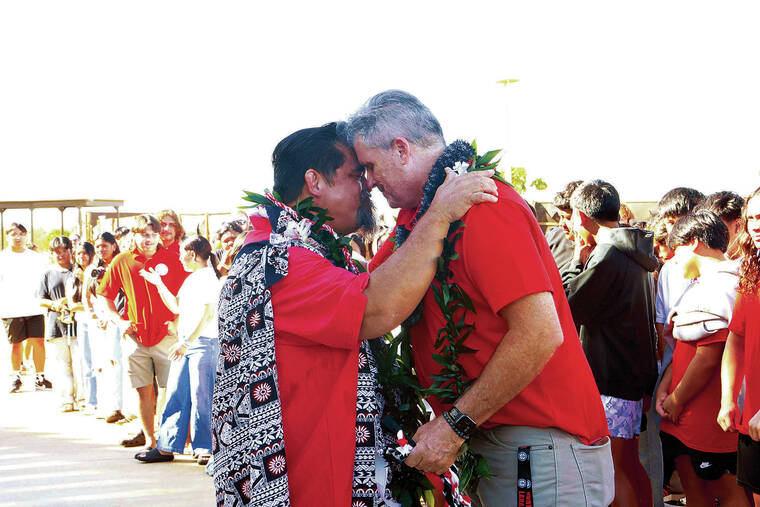
Mahalo for supporting Honolulu Star-Advertiser. Enjoy this free story!
Lahaina >> For nearly 600 Maui public school students displaced by the closure of their schools by the Lahaina wildfire, Thursday was a “first day of school” like none other.
Nearly 500 students from Lahainaluna High School were greeted with cheers for Day One at their temporary “school within a school” located at Kulanihakoi High School in Kihei — 22 miles from their beloved home campus, and a 28-mile commute for those who caught school buses from Kapalua Airport.
And for another 100-plus students who used to attend Hawaiian-language immersion programs housed at three public schools in Lahaina, it was the first day of a temporary daily “field trip” program creatively devised by their devoted teachers and parents, with the blessing of the state Department of Education — a day spent on lau hala mats under tents at Honokahua, kindergartners through 12th graders learning and singing together by the sea.
For many students across both locations, there had been little or no schooling, or organized activities, or togetherness with friends and teachers who care about them, since before summer break and then the horrific Aug. 8 fires. For many the fires have brought loss and trauma and instability.
Day One of school on Thursday, then, was for both students and teachers a jubilant day. For many it was also deeply emotional.
The yellow buses carrying Lahainaluna students were greeted with happy shouts and hand-painted signs reading “Lahaina Strong” and “Welcome, Lunas” by Kulanihakoi students and staff, many dressed in red, Lahainaluna’s school color. Kahu Greg Dela Cruz gave a Hawaiian chant and spoke of the partnership between the two schools. Several students and parents said online afterward that they were moved to tears.
“The energy that I felt (Thursday) is indescribable — I wanted to hug everybody, I wanted to talk to everybody because I care for them, and I’m looking forward to a great learning experience (over) the next three weeks,” Lahainaluna math teacher Cornelio “CJ” Ancheta said in a DOE video interview. “I’m really looking forward to a great Lahainaluna feeling even though we are in a different space.”
“I always want kids to feel wanted and welcomed, for parents to feel wanted and welcomed on campus,” Lahainaluna Principal Richard Carosso said. The enthusiastic reception that Lahainaluna students received from compassionate staff from both schools, he said, made the students “feel that we, as Lahainaluna, are back.”
The DOE said students also received an orientation, class schedules and campus tours; met with their homeroom teachers; were given welcome bags of snacks, and backpacks filled with school supplies and hygiene items; and received ID cards and school uniforms.
The DOE barred media from the first day for Lahainaluna students at Kulanihakoi but provided video footage and a news release; this was to “provide incoming students and staff from Lahainaluna High School a safe space and allow school operations to begin smoothly at the temporary campus,” a DOE spokesperson said.
The 500 Lahainaluna students at Kulanihakoi on Thursday represented about half of Lahainaluna’s normal enrollment, but DOE officials say they expect more to sign up in coming days. Lahainaluna staff and students were provided free bus transportation services from Kapalua Airport and Whalers Village in West Maui, and from War Memorial Gym in Wailuku, and more buses are being added to the route starting today. Registration for bus service is available at bit.ly/WestMauiBusApp.
The Lahainaluna students will stay as a unit on their own schedule, independent of the system for the 140 students of the newly opened Kulanihakoi High. The arrangement will remain until at least after the fall break, Oct. 9-13. The DOE’s tenative plan is to reopen the campuses of Lahainalua High, Lahaina Intermediate and Princess Nahienaena Elementary schools after the break, depending on when the schools’ soil, water and air are declared safe.
To mark their historic first day at Kulanihakoi, the Lahainaluna students took a massive group photo, and before dismissal they gathered in the cafeteria to sing a rousing rendition of their alma mater, with lyrics that go, in part: “O Lahaina, Lahainaluna nani / Ka hoku hele ho‘i o ka Pakipika / Ipu kukui ‘a a mau (Pio ‘ole)/ I ka makani Kaua‘ula” which translates to: “Oh, Lahaina, Lahainaluna nani (beauty) / The leading star of the Pacific / The ever burning torch which cannot be / Extinguished by the fierce winds of Kaua‘ula.”
“Until we can return to schooling in Lahaina, I think that it’s very important for students to be in physical (in-person) learning, mainly because we have our classmates around, and it’s just much more easier when you have your friends, your classmates — and especially what we went through, we can be through it together,” said RJ Arconado, Lahainaluna junior class president. “So I think it’s very important for us to be here and see all of our classmates again.”
Meanwhile, about 33 miles to the north, beneath the ironwood trees at the beach officially known as D.T. Fleming Beach Park, the innovative new “field trip” program that has sprung up in the wake of the fires was newly in session for Hawaiian immersion students in kindergarten through grade 12 hailing from Princess Nahienaena, Lahaina Intermediate and Lahainaluna High schools.
Three open-sided tents lashed together provided shade for the youngest keiki at midday as they listened to a story read aloud by a teacher, or kumu, a group of middle schoolers played near the sand, and the older teens participated in some social-emotional learning activities, with all instruction nearly exclusively in the melodic Hawaiian language.
But this was only Day One. The “‘aina-based learning” plan for at least the next few weeks is to emphasize hands- on experiences as the group changes locations every few days, and to have the faculty design their lessons based on where they are.
In Kahakuloa, for instance, the keiki will work in a taro patch, said kindergarten teacher Liko Rogers. In Hana they will connect with a program that offers a wood shop to teach children to build, and keiki will also learn to pound poi and to cook what they grow.
While this is not a formal school, it is an official DOE field trip and, as such, had to meet requirements for such factors as meals, bathrooms and safety.
Let not the “field trip” classification mislead, though, for there is learning happening constantly, Rogers says. “Hawaiians learn on the land, working on the land,” he said. “We have an olelo noeau (Hawaiian proverb): ‘Ma ka hana ka ‘ike” — and that is, ‘In doing is when you learn.’ … To us, this is even more valuable than inside of four walls.”
Hawaiian immersion parents and teachers for weeks have been asking the state Board of Education to allow them to establish their own temporary schooling unit for grades K-12 while the Lahaina schools remain closed, and as of yesterday the DOE said that a “learning hub” was still in discussion.
Tired of waiting and worried that the keiki were losing learning and socialization opportunities in the interim, teachers and parents brought the “field trip” model to life themselves.
The faculty “were able to do this only because of the support of our parents,” Rogers said. “Our parents are the ones who built these tents, got these supplies out here, made sure that we get fed, going to be driving for field trips. They’re the backbone of our program.”
Advocates also want the DOE to consider a permanent K-12 site for Ka Papahana Kaiapuni, the Hawaiian immersion program. Having all Hawaiian immersion students of all grades on one site has long been a dream of many Kaiapuna faculty, Rogers said. “This is something that we’ve been wanting to do for a long time,” he said, “and the fire just kind of opened the door.”
Read More: World News | Entertainment News | Celeb News
Star Ads








